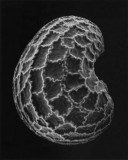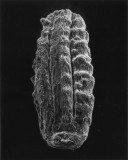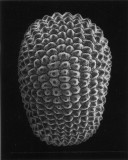| |
Das Sichtbare, das Unsichtbare und das Sehen selbst.
Wer jemals einen Braunkohlentagebau betreten hat, kennt das Gefühl, gewohnte Dimensionen und festen Boden unter den Füßen zu verlieren. Nicht nur die
beeindruckend riesigen Maschinen, sondern auch die immensen Ausmaße der weggekratzten und –geschnittenen Erde erwecken Fassungs-losigkeit und Faszination,
aber auch physisch erlebte Haltlosigkeit anlässlich des Verlustes vertrauter Koordinaten.
Über die Landschaftsfotografie gelangte Claudia Fährenkemper 1988 zur fotografischen Auseinandersetzung mit deutschen Braunkohlentagebau-gebieten. In den
folgenden sechs Jahren entstand eine umfangreiche Serie von s/w-Fotografien, die Schaufel- und Eimerkettenbagger als martialische und doch auch feingliedrigkomplexe
Wesen, die umgebende Landschaft als zerstört und gleichzeitig entstehend sowie die – nur selten sichtbaren – Menschen als winzige Begleiter der
Maschinen und Förderbänder darstellen. (…)
Entsprechend den morphologischen Details der Fördergeräte in den Tagebauen treten in den Fotografien der kommenden Jahre die Details kleinster Lebensformen
in den Vordergrund. Die Portraits von Insekten, Pflanzensamen, Kristallen und Plankton - Serien, an denen Claudia Fährenkemper kontinuierlich bis heute mit Hilfe
des Rasterelektronen-mikroskops arbeitet – bilden eine Ahnengaleriedes Mikrokosmos´. (…)
Claudia Fährenkemper geht es weder um Bilder einer artifiziellen Gegenwelt, noch um naturwissenschaftliche Dokumentation. Sie versteht es, souverän auf der
Schnittstelle zwischen Bildender Kunst und Naturwissenschaft zu arbeiten. Wie viele Künstlerinnen und Künstler – verstärkt eine Generation seit den 90er Jahren –
nutzt Fährenkemper naturwissenschaftliche Arbeitsweisen mitsamt den Methoden und Apparaturen bildgebender Verfahren, um die Kapazität des Bildes zu
erforschen. Den alten Streit in der Wissenschaft über die dokumentarische Exaktheit mikroskopischer Darstellungen, ob nämlich die Fotografie getreuliche oder
verfremdende Bilder, exakte oder beliebige Ansichten liefere, ist für die Fotografin nicht entscheidend. Sie navigiert ihren Blick in einem Reich von 40- bis
5.000facher Vergrößerung und begibt sich auf die Suche nach dem Erscheinungsbild, das alles enthält: Natürlichkeit, Manipulation, Realismus, Abstraktion und
Magie. Und immer kann alles auch ganz anders sein: was ich beobachte, ist gleichzeitig unsichtbar, was ich zu sehen glaube, ist von Schaufelradbaggern im
Tageabbau, von naturgegebenen Gesetzmäßigkeiten oder von Eingriffen durch die Künstlerin längst verändert worden.
Text von Sabina Leßmann aus: 'Glühwürmchen? Strahlentierchen? Königskerze? - Wunderliche fotografische Portraits von Claudia Fährenkemper'; im Werkbuch zur
Ausstellung im Kunstmuseum Bonn, 2007, Seite 6-9. |
The Visible, the Invisible and Seeing per se
Anyone who has ever stepped onto the scene of an soft-coal strip mine knows how it feels to lose your sense of terra firma. It is not only the impressive gigantic
machines, but also the enormous amount of gouged and dug out earth that renders us speechless, fascinated, but also physically disorientated at our loss of familiar
coordinates.
In 1988 Claudia Fährenkemper began her engagement with German open-pit mining, which she discovered while photographing landscapes. Over the following six
years, she shot a comprehensive series of b/w photographs that depict the shovel and bucket wheel excavators as martial—yet gracefully complex—creatures, the
surrounding landscape as ravaged yet simultaneously recreated, and that also capture the rare human figures as tiny escorts of the machines and conveyor belts. (…)
In the years that followed and in analogy to the morphological details of the conveyors used at open-pit sites, she foregrounded details of the tiniest life forms in her
photographs. The Portraits of insects, plant seeds, crystals and plankton—a series on which Claudia Fährenkemper has worked continually up to today using the
scanning electron microscope—provide us with an ancestral gallery of our microcosm. (…)
The complexity of Claudia Fährenkemper’s photographs originate from this strange mixture of reality and construct, of nature and artificiality. Thus the delicate
shapes seem to us just as “not-dead as not-alive”, just as much ‘image’ as three-dimensional inhabitants of a cosmos that are triggered into life neither in nature, nor
on the screen, but in an exhibition room.
Claudia Fährenkemper is not interested in pictures of an artificial ‘counterworld’ or in scientific documentation. She understands masterfully how to operate at the
interface between visual art and natural science. As do many artists—increasingly in the generation since the 1990s—Fährenkemper applies scientific ways of
working, including the methods and apparatuses of imaging techniques, to explore the capacity of the picture per se. The old dispute in science on the documentary
exactness of microscopic depictions, namely whether photography provides images that are faithful or distorted, exact or arbitrary, is not of crucial concern to this
photographer. She navigates her vision through a domain of a 40- to 5000-fold magnification and sets out on a quest for the one ‘appearance form’ that includes
everything: naturalness, manipulation, realism, abstraction and magic. And everything can always turn out differently: what I as a viewer observe is simultaneously
invisible; what I think I see can long have been changed by bucket wheel excavators in open-pit mining, by nature’s laws or by the artist’s interventions. |
|


































